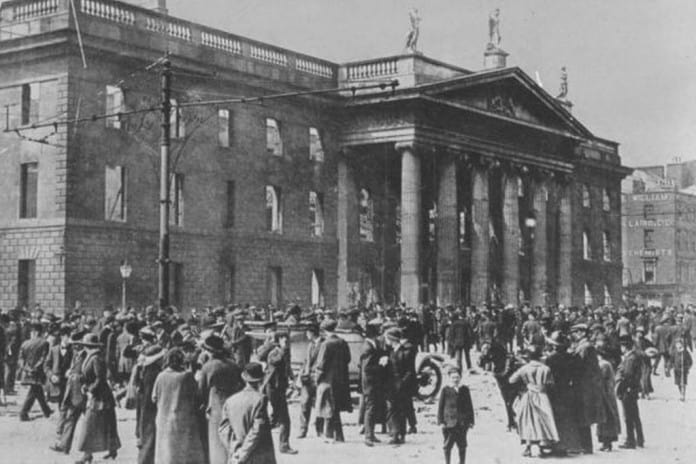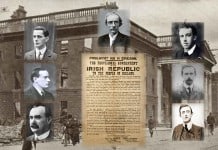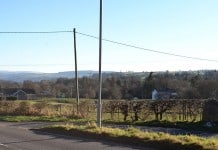
The Great Irish Famine of 1845 is regarded by many historians as a pivotal point in Irish history, and it certainly contributed to the ultimately unsuccessful Easter Rising (also known as the Easter Rebellion) of 1916 and the Declaration of Independence made by its key protagonists, including Padraig Pearse, who were soon to meet an untimely end at Kilmainham Jail. Ireland had been ravaged by a succession of famines throughout the 1800s, and going hungry was regarded as an inevitable part of life by many in rural areas. However, the 1845 famine was on another scale altogether, beginning with a potato blight that reduced the expected crop by half and compounded by even more serious failures in the following two years. The response from the London government was largely apathetic, and although some measures were implemented, they were half-hearted and generally ineffective.
Between the years 1846 and 1850 (long before the Easter Rising/Easter Rebellion, the Declaration of Independence and the deaths at Kilmainham Jail took place), the population of Ireland decreased by two million (a quarter of the population). One million people either starved to death or died from diseases associated with the famine. The other million emigrated, either to England or Scotland or further afield to North America. Many young families started to plan their futures away from Ireland once the famine had passed, because of the fear that it might happen again in the future.
The political impact of the Great Famine was seismic. Since the 1800 Act of Union, Ireland (which had for centuries been controlled to a certain extent by England) merged with Great Britain to create what was known as the ‘United Kingdom of Great Britain and Ireland’, losing its Dublin-based parliament in the process. Throughout the 19th century, this state of affairs had been opposed by various factions of Irish nationalists. This opposition now increased because of what was perceived as the blasé attitude the London government had displayed towards the famine, with many now believing that Irish lives were treated as less valuable than English ones. Essentially, they felt like second-class citizens. The growing rumble of discontent from certain quarters became increasingly audible, the crux of which was that the Irish people could only rely on themselves and should therefore become independent. A number of key figures involved in the Easter Uprising had been directly affected by the Great Famine, and all understood the awful toll that it had taken on their country.
Issues were complicated further by the onset of World War One. The plans for Home Rule (a compromise whereby Ireland would continue to be part of the UK but would have some limited autonomy) had resulted in the birth (in November 1913) of the Ulster Volunteers. They were violently opposed to any reduction of London’s power over all of Ireland, and they flew the Union Jack with pride. A nationalist movement, the Irish Volunteers, was formed in 1913 in the south of Ireland encompassing several disparate groups, including, covertly, the Irish Republican Brotherhood. Though the group had quickly grown to number around 200,000 by 1914, it then split in two with the minority group retaining the Irish Volunteers name, and it was this faction that provided much of the manpower behind the rebellion, which was led by seven key members of the IRB. It was these seven men – Padraig Pearse, Joseph Plunkett, Thomas J. Clarke, Sean McDermott, James Connolly, Thomas MacDonagh and Eamonn Ceannt – who would eventually be the signatories on the proclamation of independence.
Many months were spent planning the Rising. While the rebels had access to funds (mostly from Irishmen in America) and were led by proficient leaders, this was about the sum of their strengths. As a largely underground movement, the rebels were unable to go and canvass for support in the manner of an official political party, so their numbers were small. Additionally, many people in Ireland had welcomed the decision to delay in the implementation of Home Rule, with many actually benefiting from the new conditions caused by the war. In short, while many sympathised with their aims, few were willing to stand up and proffer any practical help.
Despite this, a small but dedicated band of militant nationalists continued to maintain Ireland should be an independent country and that Britain should have no power whatsoever over the island. As this would obviously be vehemently opposed by Britain, the only option would be to fight for independence, and thus the plans for the uprising started to take shape.
It was hoped that the rebellion would be abetted by military backing from Germany. Indeed, a large shipment of German ammunition and arms intended for use in the uprising was heading for Ireland by ship when it was detected by the British and destroyed, which impacted on the plans for a country-wide rebellion.
It was initially planned that the Rising would take place in locations right across Ireland. However, in reality it was in Dublin that the events largely played out. On Easter Monday at around 11am, the rebels converged at a number of key strategic locations across the city, including the General Post Office. Their main advantage was the fact that the British were woefully unprepared, having suffered an embarrassing intelligence failure.
While the intelligence service based at Dublin Castle were well aware that a rising was in the offing, no concrete action was taken to prevent it. British spies had heard that Eoin MacNeill, the leader of the Irish Volunteers, had cancelled the planned uprising after the loss of the German weapons. However, it seems that they were not aware that the young lawyer and committed IRB member Patrick Pearse had overruled MacNeill and had decided to go ahead regardless. This caused a fundamental rift in what should have been a united force, weakening it at this crucial point. (As an aside, in the years after the rising, Pearse’s supporters joined the Irish Republican Army, while those with a more political agenda opted to join Sinn Fein. Some did both).
The failure of the British to act on these warning signals meant the rebels were able to take control of their targeted properties with ease, and they immediately began work to make them defensible.
The GPO was the de-facto headquarters of the operation, and it was from here that one of the key figures in the rebellion, Padraig Pearse, read aloud a statement that declared that Ireland was now a republic and that a provisional government had already been appointed. The rebels had expected that the British military would mount a huge onslaught in reaction to these events, but this expectation was not met at first. Initially, the authorities were outnumbered by the rebels, so they reacted by amassing reinforcements, intelligence gathering and defending other tactical locations that appeared to have been overlooked, including Dublin Castle, the seat of government.
As the week went on, the intensity of the fighting increased in some areas and was characterised by prolonged street battles, most notably on Mount Street Bridge. Here there were far more military casualties than rebel ones, due in part to both the ineptitude of the troops and the sheer determination of the insurgents. The military suffered the loss of some 234 men, the rebels just five. Controversy raged when it was alleged that soldiers had killed in cold blood fifteen unarmed men near the Four Courts area on North King Street between the 28th and 29th of April. One of the highest-profile deaths was that of Francis Sheehy-Skeffington, a well-known pacifist. He was arrested in Dublin, locked in Portobello Barracks overnight and executed the next morning by firing squad without a trial.
Despite a few moments of breath-taking ineptitude, in general the British response to the Rising was competent. Reinforcements were quickly brought into Dublin, and by the 28th the military far outnumbered the rebels. Military strategists managed to cut off the GPO from the other rebel strongholds, and attacked it with a force that left much of the central area of the city in ruins. This in effect compelled the rebel leaders, who were based at the GPO, firstly to flee the building and secondly to acknowledge that their only remaining course of action was to unconditionally surrender. Once the GPO had fallen, it was inevitable that the other rebel outposts would follow suit, as they had been instructed to surrender rather than fight to the death in this eventuality.
A declaration of martial law was made by the British government, and in under a week the rebellion was entirely subdued. Around 450 people had lost their lives, and some 2,000 more, the majority of whom were civilians, had been wounded during the battles. As a result of this, the Rising was initially resented by many Irish people, who blamed the rebels both for the deaths and also the significant structural damage caused to Dublin. It seemed that, despite the bravado displayed by the rebels, it had quickly transpired that many citizens did not support their efforts – certainly not at first.
The seven rebel leaders, many of whom were wounded, and all of whom were weary after a week of intense fighting, were taken into custody at Kilmainham Jail following their surrender. While approximately 3,000 men who had fought for them were given prison sentences, often to be served in England, and all without trial, the seven ringleaders and eight of their key men were mercilessly beaten and eventually executed by firing squad at the jail. They were all dead by the middle of May.
The mass arrests, the rush to execute the main players and the fact that martial law remained in place well into the autumn served to swing public opinion back in favour of the rebels, and they started to be hailed by some people as martyrs who had sacrificed their lives to the cause of independence, boosting support for the independence movement. The Rising also brought home to many in the country that the only way that Ireland would ever be able to become autonomous from England was by force.
The Rising of 1916 became fundamentally entwined in the mythology of modern Ireland. The revolt was short-lived, involved relatively few people and was swiftly put down. However, the blundering, brutal reaction of the British military following the Easter Rebellion reinvented the rebels as heroes to many, while the ruins of the GPO building became the iconic image of the rebellion.
For many Irish nationalists, the events of the Easter Rising/Easter Rebellion of 1916 signified a significant step on the journey to a lasting Declaration of Independence. This was compounded by Sinn Fein’s landslide success in the 1918 election, the 1919-1921 War of Independence against Britain and the establishment of an Irish Free State. In reality, though, the bigger picture of the story of Ireland’s journey to liberation was far more complex. The independence that was achieved was not complete because Ireland was denied both unity and sovereignty. Under the terms of the 1921 Anglo-Irish treaty, the Irish Free State remained as part of the Commonwealth, and continued to declare allegiance to the Crown. In addition, six counties (now Northern Ireland) opted to stay under the auspices of the UK.
Because of these conflicting factors, the treaty was entirely unacceptable to both sides. It was this absolute opposition of both the hard-line nationalists and the committed republicans that triggered the bloody civil war of 1922-1923. Under the 1937 constitution, Ireland effectively became a republic, though not in name, with an elected president. Finally, years later on the 18th April 1949, it was declared that 26 counties would henceforth be known as the Republic of Ireland. Fittingly perhaps, it was Easter Monday, 33 years to the day since the Easter Rising/Easter Rebellion had begun and the abortive Declaration of Independence had been made on the steps of the GPO. One can only imagine how the rebels, including Padraig Pearse, who had risked their lives fighting for an independent Ireland and ultimately lost them so violently at Kilmainham jail would have reacted to this fundamental change.



